
The eastern copperhead, also known as the copperhead, is a species of venomous snake, a pit viper, endemic to eastern North America; it is a member of the subfamily Crotalinae in the family Viperidae.

The ornate chorus frog is a species of chorus frog endemic to the Southeastern United States. Their distribution ranges from North Carolina, east to the very eastern part of Louisiana, and south to northern parts of Florida.

Agkistrodon piscivorus is a species of pit viper in the subfamily Crotalinae of the family Viperidae. It is one of the world's few semiaquatic vipers, and is native to the southeastern United States. As an adult, it is large and capable of delivering a painful and potentially fatal bite. When threatened, it may respond by coiling its body and displaying its fangs. Individuals may bite when feeling threatened or being handled in any way. It tends to be found in or near water, particularly in slow-moving and shallow lakes, streams, and marshes. It is a capable swimmer and, like several species of snakes, is known to occasionally enter bays and estuaries and swim between barrier islands and the mainland.

The slender glass lizard is a legless lizard in the Glass Lizard subfamily (Anguinae) The species is endemic to the United States. Two subspecies are recognized. The lizard was originally believed to be a subspecies of the eastern glass lizard. Their name comes from their easily broken tail which they can break off themselves without ever being touched. It is difficult to find a specimen with an undamaged tail. The lizard eats a variety of insects and small animals, including smaller lizards. Snakes and other animals are known to prey on the species. Humans have a part in destroying their environment and killing their food supply with insecticides. The lizard is considered to be a least-concern species according to the International Union for Conservation of Nature (IUCN), though it is vulnerable in Iowa and endangered in Wisconsin. It is important to note that the streamlined, legless species is often confused with snakes. Glass Lizards, however, differ from snakes as they possess a moveable eyelid, which is absent in snakes. Another way to distinguish glass lizards from snakes is the presence of an external ear opening, which are absent in snakes.
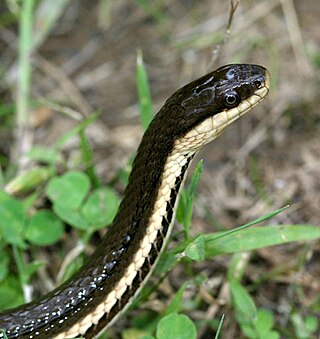
The queen snake is a species of nonvenomous semiaquatic snake, a member of the subfamily Natricinae of the family Colubridae. The species is endemic to North America.
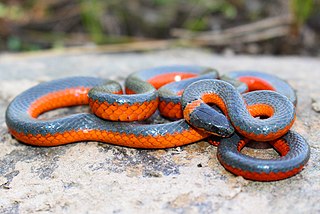
Diadophis punctatus, commonly known as the ring-necked snake or ringneck snake, is a harmless species of colubrid snake found throughout much of the United States, central Mexico, and south-eastern Canada. Ring-necked snakes are secretive, nocturnal snakes, so are rarely seen during the day time. They are best known for their unique defense posture of curling up their tails, exposing their bright red-orange posterior, ventral surface when threatened.

Diadophis punctatus regalis, commonly known as the regal ringneck snake, is a subspecies of ringneck snake endemic to the southwestern United States and northern Mexico.
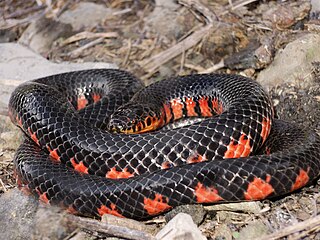
The mud snake is a species of nonvenomous, semiaquatic, colubrid snake endemic to the southeastern United States.

The northern two-lined salamander is a species of salamander in the family Plethodontidae found in Canada and the United States. Its natural habitats are temperate forests, temperate shrubland, rivers, intermittent rivers, freshwater marshes, freshwater springs, arable land, and urban areas. It is more water-oriented than the related northern redback salamander, and can often be found in and around water such as rain puddles, streams, swamps, and damp stream beds, whereas the northern redback tends to be found in damp ground, but usually not near open water.

The black-knobbed map turtle, formerly known as the black-knobbed sawback, is a small to medium-sized aquatic turtle with light gray skin. Some of the most distinguishing characteristics of the black-knobbed map turtle, and the Graptemys genus, are the protruding "spikes" on the turtle's carapace. This species inhabits mainly the fall lines of rivers in the Mobile Bay drainage, in Alabama and Mississippi.
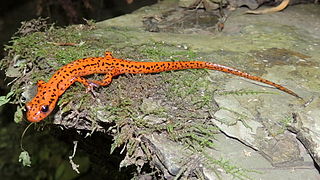
The spotted-tail salamander, also known as a "cave salamander", is a species of brook salamander.

Lampropeltis getula, commonly known as the eastern kingsnake, common kingsnake, or chain kingsnake, is a harmless colubrid species endemic to the United States and Mexico. It has long been a favorite among collectors. Nine subspecies are currently recognized, including the nominate subspecies described here.

Diadophis punctatus edwardsii, commonly known as the northern ringneck snake, is a subspecies of Diadophis punctatus, a snake in the family Colubridae. The subspecies is endemic to North America.

Diadophis punctatus arnyi, also known commonly as the prairie ringneck snake, is a subspecies of small, thin snake in the family Dipsadidae. The subspecies is native to the Midwestern United States.
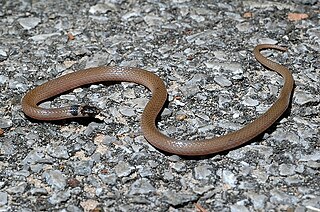
The southeastern crown snake is a common species of small colubrid snake endemic to the southeastern United States.

Pituophis catenifer deserticola, commonly known by its standardized English name since the 1950s, the Great Basin gophersnake, is a subspecies of nonvenomous colubrid snake ranging in parts of western United States and adjacent southwestern Canada.
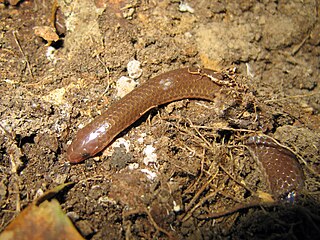
Carphophis amoenus, commonly known as the worm snake, is a species of nonvenomous colubrid snake endemic to the eastern United States. C. amoenus can be found east of the Mississippi, from southwest Massachusetts south to southern Alabama west to Louisiana and then north to Illinois. This species of snake protects a large range, and normally prefers a moist habitat in the rocky woodlands, under rotten wood of logs and stumps. Though this snake is quite abundant over its range, it is rarely seen because of its dormant lifestyle and where it usually resides. This snake is most common on the edges or in the ecotonal areas of open to thick woodlands, and the borders of wetlands. It may also be found in the grasslands next to woodlands. The best chance to spot it is after heavy rains, when its small size and distinct color make it easy to spot. This species prefers moist soil inhabited by earthworms, which are its main prey, so the soil needs to be sufficiently moist. The snake's skin naturally evaporates water; so the soil needs to be moist enough to offset this. C. amoenus is mostly found under rocks and in sufficient leaf litter during the extreme daytime heat.
The northern pygmy salamander is a terrestrial species of salamander in the family Plethodontidae and genus Desmognathus. Along with the southern pygmy and the seepage salamander, these are some of the smallest salamander species in North America and can be found in higher elevations in the southern Appalachians.



















